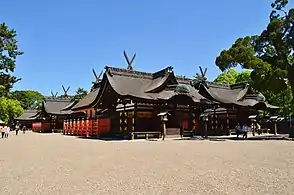| Shikaumi Shrine | |
|---|---|
 | |
| Religion | |
| Affiliation | Shinto |
| Deity | Watatsumi, Empress Jingu, |
Shikaumi Shrine is a Shinto shrine located in Fukuoka, Kyushu, Japan.[1][2] It is located on Shikanoshima island.[3]
The shrine has historical connections to foreign wars as it was the place from which Empress Jingū launched her invasion of Korea, and it was also a site of conflict during the Mongol invasions of Japan.[1]
The Azumi people, who inhabited Kyushu, traditionally followed the sea deity, Watatsumi.[4] Shikaumi Shrine is considered this deity's ancestral shrine, and also honors Watatsumi[5] and Azumi-no-isora.[6]
The primary revered figures of the shrine include, on the left, Nakatsu Watatsumi no Kami (middle depth god) and Empress Jingū; in the middle, Sokotsu Watatsumi no Kami (depths god) and Tamayorihime no Kami; and on the right, Uwatsu Watatsumi no Kami (sea surface god) and Emperor Ōjin.[7]: xxvi
The three watatsumis are speculated to correspond to historical fishing practices[7]: xxviii
Empress Jingū and Emperor Ojin are both worshipped at the shrine due to their relationship with the myth of the invasion of the Three Han.[7]: xxvii Empress Jingu had sex with the god Azumi-no-isora while pregnant with Emperor Ojin after he said from the womb that it was acceptable, and then Azumi no Isora gave her the tide jewels.[7]: xxvii Watatsumi Shrine which was founded by Empress Jingu when she returned from the Three Han (三韓, Korea) campaign.[8] and also worships Watatsumi[9] and Ikasuri Shrine and Ikuta Shrine which were also founded by her at the time.[9]
The biennial gojinkosai ceremony held at the shrine is recognized as an intangible cultural property by the prefecture.[5]
The shrine incorporates a deer motif in its rituals and designs. The deer motif is significant to the Azumi people and their beliefs,[1][10] and is a common feature in the historic culture of the region.[1][10]
References
- 1 2 3 4 Wakabayashi, Haruko. "The Mongol Invasions and the Making of the Iconography of Foreign Enemies: The Case of Shikaumi jinja engi".
{{cite journal}}: Cite journal requires|journal=(help) - ↑ "Shikaumi Shrine". The Official Guide to Fukuoka City - yokanavi.com. Retrieved 2023-04-06.
- ↑ "Shikaumi-jinja Shrine Okitsu-gu Shrine". VISIT FUKUOKA. Retrieved 2023-04-08.
- ↑ Rambelli, F (2018). The Sea and The Sacred in Japan. Camden: Bloomsbury Academic Publishing. pp. preface. ISBN 978-1350062870.
- 1 2 "Shikaumi Jinja Gojinkosai". DyDo GROUP Matsuri of Japan. Archived from the original on 2020-01-31. Retrieved 2020-04-16.
- ↑ Japanese Journal of Religious Studies. International Institute for the Study of Religions. 1993.
- 1 2 3 4 Rambelli, F (2018). The Sea and The Sacred in Japan. Camden: Bloomsbury Academic Publishing. ISBN 978-1350062870.
- ↑ "Shinto shrines | Japan | Rods Shinto". shintoshrines. Retrieved 2023-04-04.
- 1 2 "Watatsumi Shrine | 海神社 |Hyogo-ken, Kobe-shi". shintoshrines. Retrieved 2023-04-06.
- 1 2 Rambelli, F (2018). The Sea and The Sacred in Japan. Camden: Bloomsbury Academic Publishing. pp. preface. ISBN 978-1350062870.

